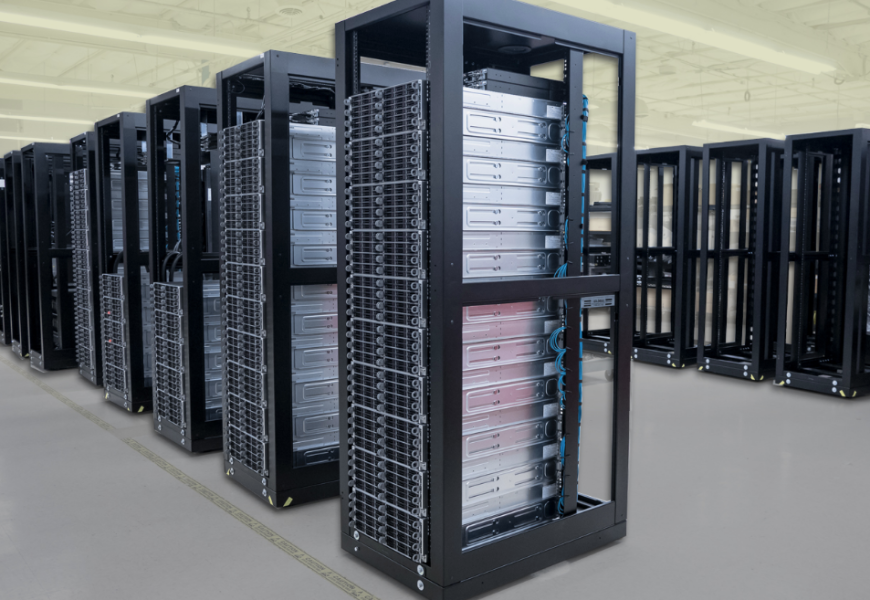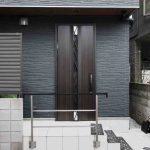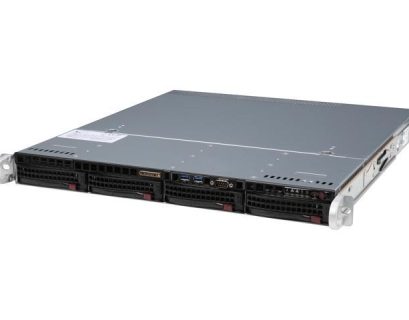As businesses and organizations increasingly prioritize sustainability, manufacturers are advancing the development of environmentally friendly rack servers. Once associated with high energy use and non-eco-friendly materials, these critical components of data centers and enterprise systems are undergoing transformative changes to align with greener practices.
Today, manufacturers focus on reducing the environmental impact of rack servers through several key innovations. For instance, sustainable materials are being incorporated into designs, while advanced cooling technologies minimize energy use. Additionally, energy-efficient architectures ensure high performance without excessive power consumption. Let us explore how these advancements are reshaping rack servers into more eco-conscious solutions for modern enterprises.
According to the 6Wresearch, a rack server helps to manage a vast amount of data easily, allowing businesses to run smoothly.
1. Energy-Efficient Power Systems
One of the primary concerns with traditional rack server has always been their high power consumption. Data centers, where these servers are used, can consume enormous amounts of electricity, leading to higher energy costs and a larger environmental impact. To address this issue, manufacturers are focusing on energy-efficient power systems.
What Manufacturers Are Doing:
- Power Supply Units (PSUs): Rack servers now feature highly efficient power supplies. Many are rated with an 80 PLUS certification, which means they convert more than 80% of electrical power into usable energy, with minimal energy wasted as heat.
- Dynamic Power Management: Modern rack servers come equipped with dynamic power management systems that automatically adjust power usage depending on the workload. This reduces unnecessary power consumption during idle times, further lowering the environmental impact.
- Low-Power Processors: Energy-efficient processors, such as those designed for low-power consumption, are being integrated into rack servers to ensure less energy is required to perform the same tasks.
Why It Matters: Reducing energy consumption not only cuts down on the carbon footprint but also reduces operational costs for businesses that rely on data centers.
2. Use of Sustainable Materials
The materials used in manufacturing rack servers are another area where manufacturers are making eco-friendly improvements. Traditional rack servers often contain plastics, metals, and other materials that are not biodegradable or easily recyclable. However, manufacturers are increasingly adopting sustainable materials to reduce the environmental impact.
What Manufacturers Are Doing:
- Recyclable Materials: Many manufacturers are shifting toward using recyclable or eco-friendly materials for the components of their rack servers. For example, some servers are made with recyclable aluminum or steel in their frames and chassis, while others use biodegradable plastics in their outer casings.
- Reduced Use of Hazardous Materials: The use of harmful chemicals such as lead, mercury, and cadmium has been reduced or eliminated from many servers. These chemicals, often found in older electronics, can leach into the environment when discarded improperly, contributing to pollution.
Why It Matters: Using sustainable materials ensures that when the servers reach the end of their life cycle, they can be recycled more easily and have less negative impact on the environment. It also supports a circular economy, where materials are reused and recycled rather than discarded.
3. Improved Cooling Technologies
Cooling is another major concern in the operation of rack servers. Data centers often rely on traditional air conditioning systems, which consume a lot of energy to keep servers at optimal temperatures. This not only drives up electricity costs but also increases carbon emissions. As a result, manufacturers are innovating with cooling technologies to make rack servers more eco-friendly.
What Manufacturers Are Doing:
- Liquid Cooling: Liquid cooling technologies are becoming more common in modern rack servers. Liquid cooling systems, such as direct-to-chip cooling, use liquids to absorb heat from the server’s components and carry it away more efficiently than air. This helps lower energy consumption by reducing the need for traditional air-conditioning systems.
- Immersion Cooling: Some manufacturers are exploring immersion cooling, where servers are submerged in a special non-conductive liquid that absorbs heat more effectively than air. This approach can lead to even greater energy savings, as it can eliminate the need for air-based cooling.
- Free-air cooling: Another eco-friendly cooling method is free-air cooling, where outside air is used to cool the servers, especially in colder climates. This reduces the reliance on mechanical cooling systems, cutting energy use, and improving efficiency.
Why It Matters: By using advanced cooling technologies, manufacturers can reduce the energy required to maintain optimal server temperatures. This directly leads to lower electricity consumption and, in turn, a reduced carbon footprint.
4. Modular and Scalable Designs
The trend toward modular and scalable server designs has also contributed to the environmental friendliness of modern rack servers. Traditional servers are often built with fixed configurations, meaning that businesses sometimes end up using more power and resources than necessary. Modular designs, on the other hand, allow businesses to add or remove components as needed, reducing waste and inefficiency.
What Manufacturers Are Doing:
- Modular Servers: Manufacturers now offer servers that are highly customizable and scalable. This means that businesses can choose the specific components they need and upgrade only the necessary parts, reducing unnecessary power consumption and waste.
- Efficient Space Usage: With modular systems, companies can also optimize their space usage, ensuring that they only use as much hardware as needed. This helps reduce the environmental impact associated with underused or idle equipment.
Why It Matters: Modular designs allow businesses to operate more efficiently, using fewer resources and reducing the environmental impact of their infrastructure. They also ensure that equipment is not outdated or over-provisioned, which can waste both energy and materials.
5. Server Virtualization and Cloud Solutions
Another important development in creating environmentally friendly rack servers is the increased use of server virtualization and cloud computing solutions. Virtualization allows multiple virtual servers to run on a single physical server, maximizing the use of available resources and reducing the need for additional hardware.
What Manufacturers Are Doing:
- Pre-Configured Virtualization: Many modern rack servers are designed to support virtualization technologies, allowing businesses to run multiple applications and services on a single server. This reduces the need for additional hardware, which in turn lowers power consumption.
- Cloud Computing Integration: With more businesses moving their operations to the cloud, many rack servers are being designed to work seamlessly with cloud infrastructure. This enables more efficient use of computing resources and further reduces the environmental impact of on-premises servers.
Why It Matters: Virtualization and cloud computing help reduce the need for additional hardware and infrastructure, lowering both energy consumption and waste. This results in a more sustainable IT operation overall.
Conclusion
Manufacturers are making significant strides in creating environmentally friendly rack servers, addressing the growing demand for sustainable technology. By focusing on energy-efficient power systems, sustainable materials, advanced cooling technologies, modular designs, and virtualization solutions, they are reducing the environmental impact of these powerful machines.
As businesses strive to meet sustainability goals, environmentally friendly rack servers offer a compelling solution to reduce energy consumption, minimize electronic waste, and cut operational costs. With these innovations, manufacturers are not only improving the performance of their products but also ensuring that they can help create a greener, more sustainable future for the technology industry.
By selecting eco-friendly rack servers, businesses can do their part in supporting a more sustainable digital ecosystem while continuing to meet their performance needs.










